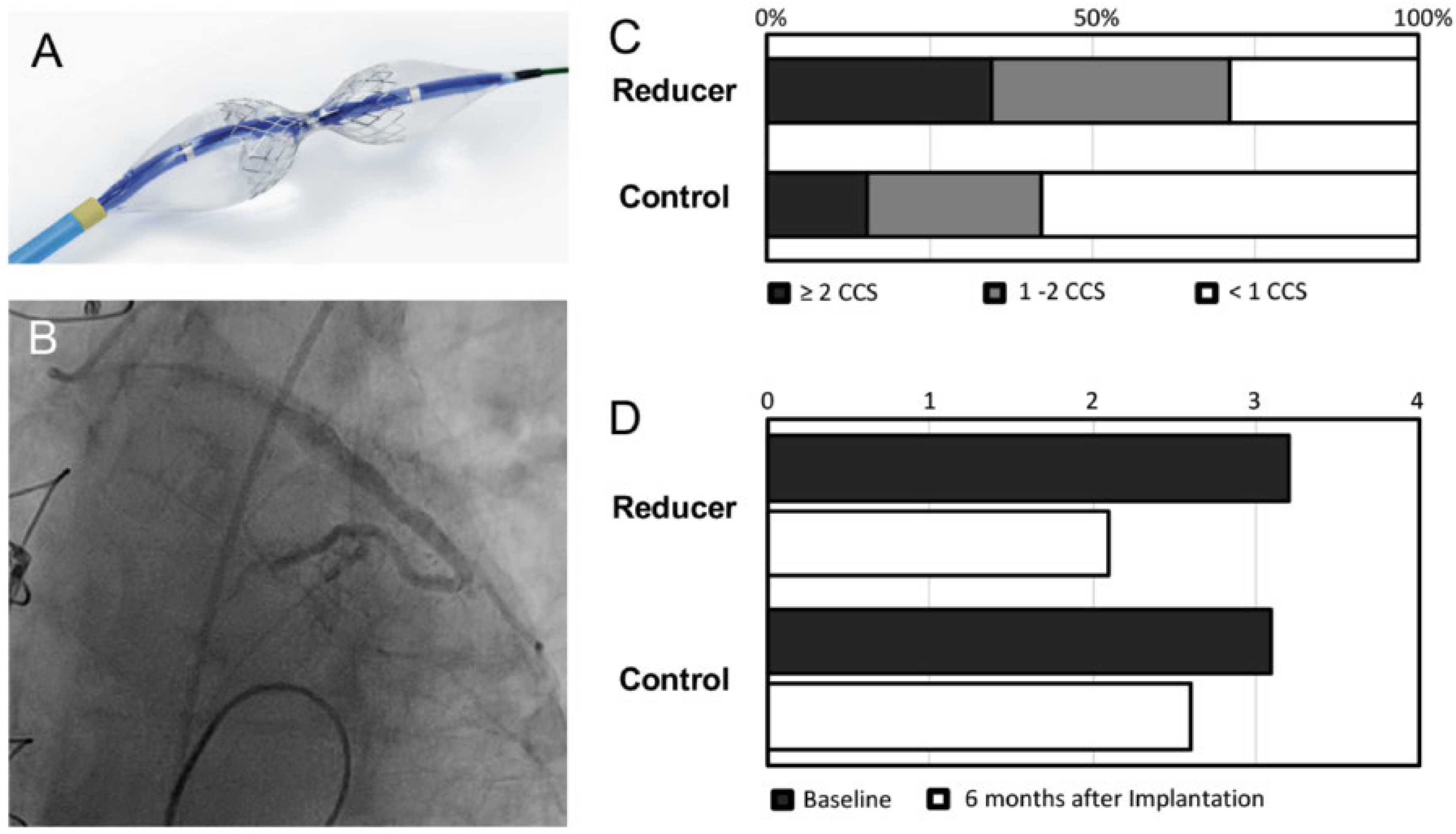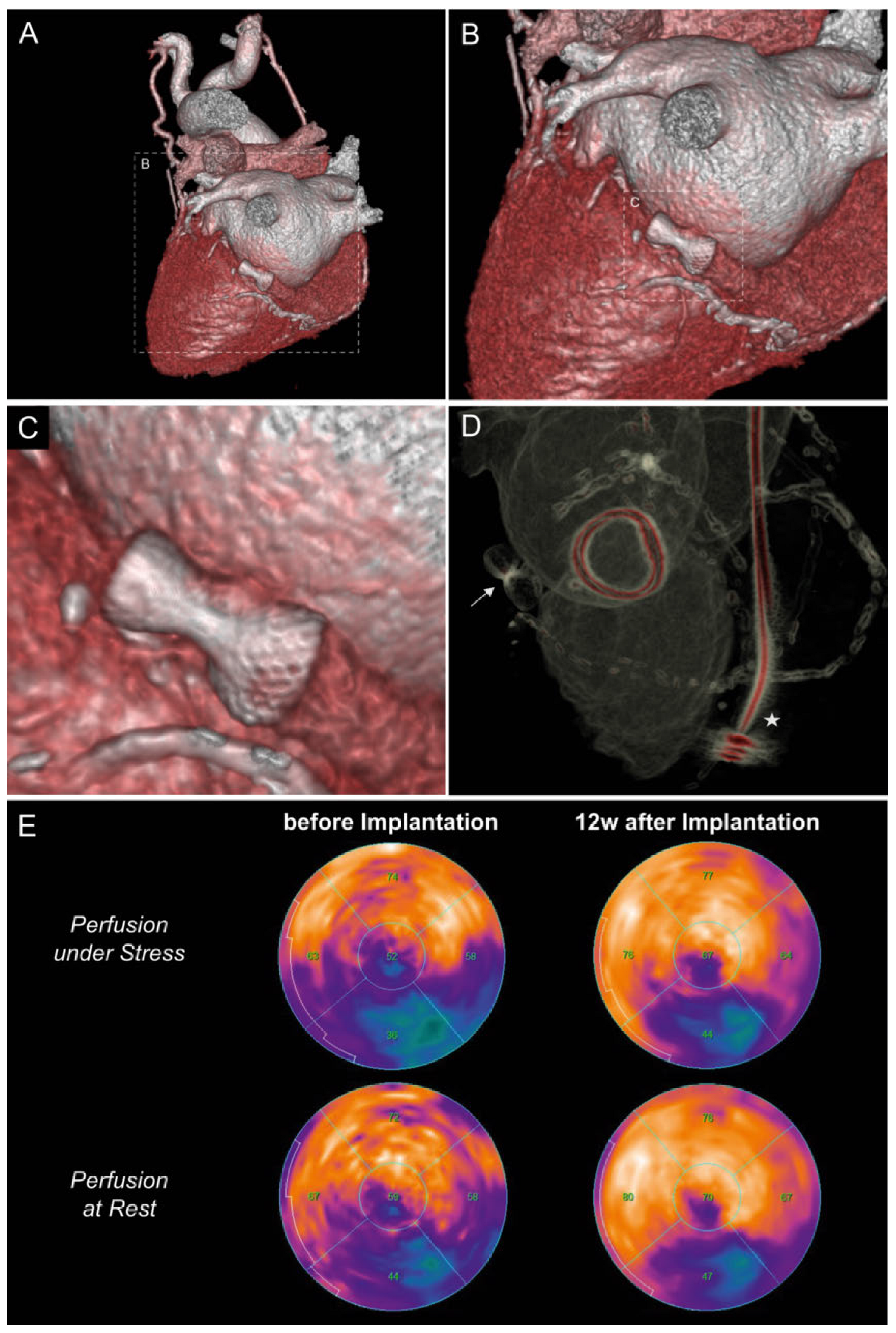Coronary Sinus Reducer Device for Patients with Refractory Angina
Abstract
Introduction
Description of the case
Patient history
Stepwise description of the implantation of the device
Postinterventional course
Discussion
The subendocardial microvasculature and its contribution overall
Prevalence of refractory angina in patients withcoronary artery disease
Limitations of PCI and CABG in this patient population and currently available medications to improve this
Mechanistic approach of the coronary sinus reducer and current indications
- Elevation of the coronary sinus pressure increases the back pressure in the precapillary arteriolar system and thereby enhances the dilatation of the constricted subendocardial capillaries, which shifts coronary flow from the subepicardium to the subendocardium.
- Coronary blood flow and myocardial contractility decrease in the infarcted myocardium, resulting in decreased regional perfusion pressure. When the coronary sinus pressure rises, this promotes a shift in blood flow within pre-existing collaterals from nonischaemic (high tissue pressure) to ischaemic (low tissue pressure) myocardium, specifically reducing subendocardial ischaemia [23]. This effect was observed with and without intact vasomotor tone, the later being induced by adenosine infusion [24].
- Since the subendocardium is at significantly higher risk of ischaemia, coronary sinus occlusion reverses the subendocardial to epicardial blood flow ratio towards the subendocardium. In addition, early studies in pigs demonstrated that full occlusion or permanent constriction of the coronary sinus leads to neovascularisation (development of new collaterals) within the epicardial and intramyocardial layers of the heart.
Ongoing studies
Conclusion
Disclosure statement
References
- Beck, C.S.; Leighninger, D.S. Scientific basis for the surgical treatment of coronary artery disease. J Am Med Assoc 1955, 159, 1264–1271. [Google Scholar] [CrossRef]
- Feigl, E.O. The paradox of adrenergic coronary vasoconstriction. Circulation 1987, 76, 737–745. [Google Scholar] [CrossRef] [PubMed]
- Crea, F.; Galassi, A.R.; Carlos Kaski, J.; Pupita, G.; El Tamimi, H.; Davies, G.J.; et al. Effect of theophylline on exercise-induced myocardial ischaemia. Lancet 1989, 333, 683–686. [Google Scholar] [CrossRef]
- Mannheimer, C.; Camici, P.; Chester, M.R.; Collins, A.; DeJongste, M.; Eliasson, T.; et al. The problem of chronic refractory angina; report from the ESC Joint Study Group on the Treatment of Refractory Angina. Eur Heart J 2002, 23, 355–370. [Google Scholar] [CrossRef] [PubMed]
- Mukherjee, D.; Comella, K.; Bhatt, D.L.; Roe, M.T.; Patel, V.; Ellis, S.G. Clinical outcome of a cohort of patients eligible for therapeutic angiogenesis or transmyocardial revascularization. Am Heart J 2001, 142, 72–74. [Google Scholar] [CrossRef]
- Brorsson, B.; Bernstein, S.J.; Brook, R.H.; Werkö, L. Quality of life of patients with chronic stable angina before and four years after coronary revascularisation compared with a normal population. Heart 2002, 87, 140–145. [Google Scholar] [CrossRef]
- Williams, B.; Menon, M.; Satran, D.; Hayward, D.; Hodges, J.S.; Burke, M.N.; et al. Patients with coronary artery disease not amenable to traditional revascularization: prevalence and 3-year mortality. Catheter Cardiovasc Interv 2010, 75, 886–891. [Google Scholar] [CrossRef] [PubMed]
- Henry, T.D.; Satran, D.; Hodges, J.S.; Johnson, R.K.; Poulose, A.K.; Campbell, A.R.; et al. Long-term survival in patients with refractory angina. Eur Heart J 2013, 34, 2683–2688. [Google Scholar] [CrossRef]
- Lenzen, M.; Scholte op Reimer, W.; Norekvål, T.M.; De Geest, S.; Fridlund, B.; Heikkilä, J.; et al. Pharmacological treatment and perceived health status during 1-year follow up in patients diagnosed with coronary artery disease, but ineligible for revascularization. Results from the Euro Heart Survey on Coronary Revascularization. Eur J Cardiovasc Nurs 2006, 5, 115–121. [Google Scholar] [CrossRef]
- Chaitman, B.R.; Skettino, S.L.; Parker, J.O.; Hanley, P.; Meluzin, J.; Kuch, J.; MARISA Investigators; et al. Anti-ischemic effects and long-term survival during ranolazine monotherapy in patients with chronic severe angina. J Am Coll Cardiol 2004, 43, 1375–1382. [Google Scholar] [CrossRef]
- Chaitman, B.R.; Pepine, C.J.; Parker, J.O.; Skopal, J.; Chumakova, G.; Kuch, J.; et al. Combination Assessment of Ranolazine In Stable Angina (CARISA) Investigators. Effects of ranolazine with atenolol, amlodipine, or diltiazem on exercise tolerance and angina frequency in patients with severe chronic angina: a randomized controlled trial. JAMA 2004, 291, 309–316. [Google Scholar] [CrossRef]
- Kosiborod, M.; Arnold, S.V.; Spertus, J.A.; McGuire, D.K.; Li, Y.; Yue, P.; et al. Evaluation of ranolazine in patients with type 2 diabetes mellitus and chronic stable angina: results from the TERISA randomized clinical trial (Type 2 Diabetes Evaluation of Ranolazine in Subjects With Chronic Stable Angina). J Am Coll Cardiol 2013, 61, 2038–2045. [Google Scholar] [CrossRef]
- Scirica, B.M.; Morrow, D.A.; Hod, H.; Murphy, S.A.; Belardinelli, L.; Hedgepeth, C.M.; et al. Effect of ranolazine, an antianginal agent with novel electrophysiological properties, on the incidence of arrhythmias in patients with non ST-segment elevation acute coronary syndrome: results from the Metabolic Efficiency With Ranolazine for Less Ischemia in Non ST-Elevation Acute Coronary Syndrome Thrombolysis in Myocardial Infarction 36 (MERLIN-TIMI 36) randomized controlled trial. Circulation 2007, 116, 1647–1652. [Google Scholar] [CrossRef]
- Phan, T.T.; Shivu, G.N.; Choudhury, A.; Abozguia, K.; Davies, C.; Naidoo, U.; et al. Multi-centre experience on the use of perhexiline in chronic heart failure and refractory angina: old drug, new hope. Eur J Heart Fail 2009, 11, 881–886. [Google Scholar] [CrossRef] [PubMed]
- Vitale, C.; Spoletini, I.; Malorni, W.; Perrone-Filardi, P.; Volterrani, M.; Rosano, G.M. Efficacy of trimetazidine on functional capacity in symptomatic patients with stable exertional angina – the VASCO-angina study. Int J Cardiol 2013, 168, 1078–1081. [Google Scholar] [CrossRef] [PubMed]
- IONA Study Group. Effect of nicorandil on coronary events in patients with stable angina: the Impact Of Nicorandil in Angina (IONA) randomised trial. Lancet 2002, 359, 1269–1275. [Google Scholar] [CrossRef] [PubMed]
- Tardif, J.C.; Ponikowski, P.; Kahan, T.; ASSOCIATE Study Investigators. Efficacy of the I(f) current inhibitor ivabradine in patients with chronic stable angina receiving beta-blocker therapy: a 4-month, randomized, placebo-controlled trial. Eur Heart J 2009, 30, 540–548. [Google Scholar] [CrossRef]
- Pan, X.; Bao, H.; Si, Y.; Xu, C.; Chen, H.; Gao, X.; et al. Spinal Cord Stimulation for Refractory Angina Pectoris: A Systematic Review and Meta-analysis. Clin J Pain 2017, 33, 543–551. [Google Scholar] [CrossRef]
- Henry, T.D.; Losordo, D.W.; Traverse, J.H.; Schatz, R.A.; Jolicoeur, E.M.; Schaer, G.L.; et al. Autologous CD34+ Cell Therapy Improves Exercise Capacity, Angina Frequency and Reduces Mortality in No-Option Refractory Angina: A Patient-Level Pooled Analysis of Randomized Double-Blinded Trials. Eur Heart J, 2018; Epub ahead of print. [Google Scholar] [CrossRef]
- Hartikainen, J.; Hassinen, I.; Hedman, A.; Kivelä, A.; Saraste, A.; Knuuti, J.; et al. Adenoviral intramyocardial VEGF-DΔNΔC gene transfer increases myocardial perfusion reserve in refractory angina patients: a phase I/IIa study with 1-year follow-up. Eur Heart J 2017, 38, 2547–2555. [Google Scholar] [CrossRef]
- Mohl, W.; Glogar, D.H.; Mayr, H.; Losert, U.; Sochor, H.; Pachinger, O.; et al. Reduction of infarct size induced by pressure-controlled intermittent coronary sinus occlusion. Am J Cardiol 1984, 53, 923–928. [Google Scholar] [CrossRef]
- Syeda, B.; Schukro, C.; Heinze, G.; Modaressi, K.; Glogar, D.; Maurer, G.; et al. The salvage potential of coronary sinus interventions: meta-analysis and pathophysiologic consequences. J Thorac Cardiovasc Surg 2004, 127, 1703–1712. [Google Scholar] [CrossRef] [PubMed]
- Sato, M.; Saito, T.; Mitsugi, M.; Saitoh, S.; Niitsuma, T.; Maehara, K.; et al. Effects of cardiac contraction and coronary sinus pressure elevation on collateral circulation. Am J Physiol 1996, 271 Pt 2, H1433–H1440. [Google Scholar] [CrossRef]
- Ido, A.; Hasebe, N.; Matsuhashi, H.; Kikuchi, K. Coronary sinus occlusion enhances coronary collateral flow and reduces subendocardial ischemia. Am J Physiol Heart Circ Physiol 2001, 280, H1361–H1367. [Google Scholar] [CrossRef]
- Verheye, S.; Jolicœur, E.M.; Behan, M.W.; Pettersson, T.; Sainsbury, P.; Hill, J.; et al. Efficacy of a device to narrow the coronary sinus in refractory angina. N Engl J Med 2015, 372, 519–527. [Google Scholar] [CrossRef] [PubMed]
- Banai, S.; Ben Muvhar, S.; Parikh, K.H.; Medina, A.; Sievert, H.; Seth, A.; et al. Coronary sinus reducer stent for the treatment of chronic refractory angina pectoris: a prospective, open-label, multicenter, safety feasibility first-in-man study. J Am Coll Cardiol 2007, 49, 1783–1789. [Google Scholar] [CrossRef] [PubMed]
- Konigstein, M.; Giannini, F.; Banai, S. The Reducer Device in Patients with Angina Pectoris: Mechanisms, Indications, and Perspectives. Eur Heart J, 2017; Epub ahead of print. [Google Scholar] [CrossRef]



© 2018 by the author. Attribution - Non-Commercial - NoDerivatives 4.0.
Share and Cite
Kahr, P.C.; Giannopoulos, A.A.; Buechel, R.R.; Gaemperli, O.; Banai, S.; Obeid, S.; Lüscher, T.F. Coronary Sinus Reducer Device for Patients with Refractory Angina. Cardiovasc. Med. 2018, 21, 105. https://doi.org/10.4414/cvm.2018.00553
Kahr PC, Giannopoulos AA, Buechel RR, Gaemperli O, Banai S, Obeid S, Lüscher TF. Coronary Sinus Reducer Device for Patients with Refractory Angina. Cardiovascular Medicine. 2018; 21(4):105. https://doi.org/10.4414/cvm.2018.00553
Chicago/Turabian StyleKahr, Peter C., Andreas A. Giannopoulos, Ronny R. Buechel, Oliver Gaemperli, Shmuel Banai, Slayman Obeid, and Thomas F. Lüscher. 2018. "Coronary Sinus Reducer Device for Patients with Refractory Angina" Cardiovascular Medicine 21, no. 4: 105. https://doi.org/10.4414/cvm.2018.00553
APA StyleKahr, P. C., Giannopoulos, A. A., Buechel, R. R., Gaemperli, O., Banai, S., Obeid, S., & Lüscher, T. F. (2018). Coronary Sinus Reducer Device for Patients with Refractory Angina. Cardiovascular Medicine, 21(4), 105. https://doi.org/10.4414/cvm.2018.00553



